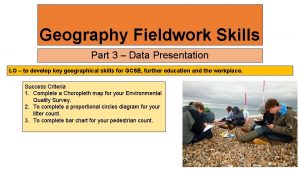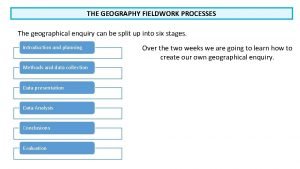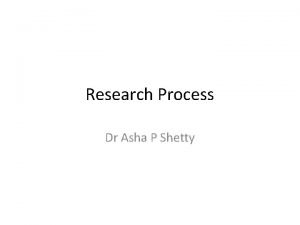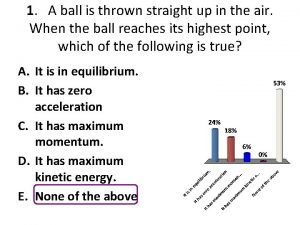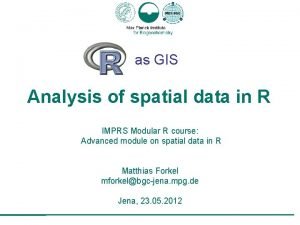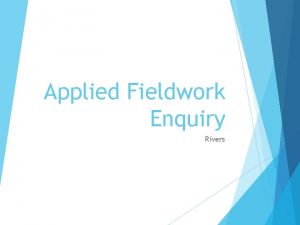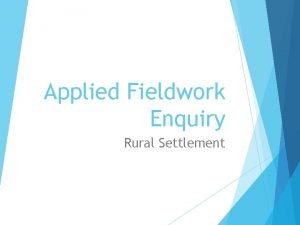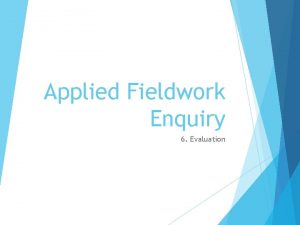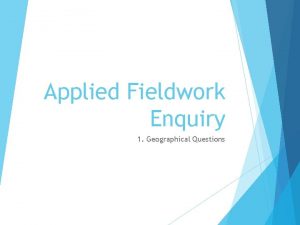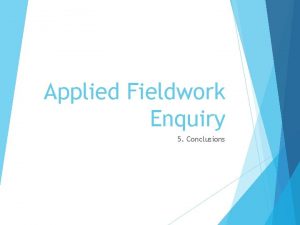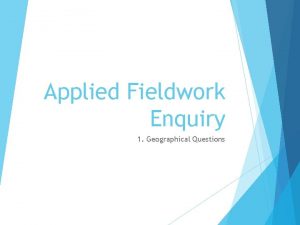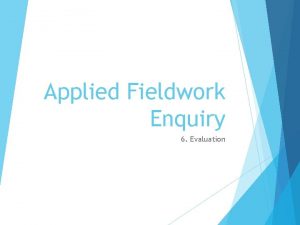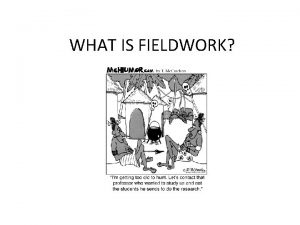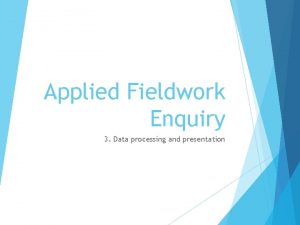Applied Fieldwork Enquiry 2 Data collection The six


















- Slides: 18

Applied Fieldwork Enquiry 2. Data collection

The six stages of the enquiry process Ask questions Evaluate the process Collect data Process & present data Draw conclusions Analysis and application of wider understanding

How is evidence collected? This involves using appropriate equipment to obtain accurate and reliable data from both primary and secondary sources It includes: Selecting appropriate locations for data collection Justifying sampling size and type Collecting data using quantitative and qualitative techniques

Sampling method Random – every point (or line) stands an equal chance of being selected. You can use a random numbers table or phone app to select a two digit number that can be related to a map or tape measure Systematic – data collected at regular intervals, which ensures that an even spread of data is collected, for example, along a beach transect Stratified – sites are located deliberately introducing bias, such as access points along the course of a river Explain why a particular sampling method has been used in your investigation

Discuss sampling strategies for these examples of data collection Measuring width and depth Measuring velocity Measuring pebble size © 2017 Snowdonia National Park Authority SNPA

Sample size The aim of a sample is to collect enough data to be representative of the population as a whole. . . Without having to measure every individual! The larger the sample, the more reliable it is likely to be, for example: When studying pebbles, aim for a minimum of 30 If you plan to draw a scatter graph, aim for 10+ sets of data about If you intend to draw an isoline map, make you have a good spread of points sure

Fieldwork advice from the RGS http: //rgs. org

How to obtain accurate and reliable results Geography fieldwork involves collecting accurate data to enable us to draw reliable conclusions: practice using unfamiliar equipment take time and care to make sure the data you collect is precise and accurate double-check your measurements record your results accurately

Quantitative techniques Techniques should include those that measure: flow (for example, discharge, infiltration, traffic) scale (for example, river width, pebble size, gradient) spatial pattern (for example, retail land use, sediment sorting) temporal change (for example, temperature, rainfall, pressure)

Quantitative techniques © 2017 Snowdonia National Park Authority SNPA What methods are being used? What is being measured?

Qualitative techniques What methods are being used? What is being measured?

Secondary sources Crime data Consumer Data Research Centre Crime data Raw data from Police. uk website. Crime map for Keighley by Police. uk / Contains public sector information licensed under the Open Government Licence v 3. 0. Median house price in Keighley, West Yorkshire by CDRC / Contains National Statistics & Ordnance Survey data © Crown copyright & database right 2014 -5.

Secondary sources Natural Resources Wales – satellite flood risk map

Secondary sources British Geological Survey – Geology of Britain https: //www. geography-fieldwork. org/gcse/coasts/coastal-processes/secondary-data/

Secondary sources Aerial and satellite photos – Ynyslas sand dunes

Take a look

Can you sort the data sources?

Nominated criteria Table A: Methodologies Table B: Conceptual framework 2018: Geographical flows 2018: Cycles and flows 2019: Qualitative surveys 2019: Place 2020: Use of transects 2020: Sphere of Influence
 Complex data presentation geography
Complex data presentation geography Landsat collection 1 vs collection 2
Landsat collection 1 vs collection 2 Sightd
Sightd What is geographical enquiry
What is geographical enquiry Conceptual phase of research process
Conceptual phase of research process Sequent occupance
Sequent occupance What is field work in geography
What is field work in geography Fieldwork sf
Fieldwork sf Geography fieldwork in school grounds
Geography fieldwork in school grounds Research procedure in methodology
Research procedure in methodology Data collection secondary data sources
Data collection secondary data sources A polygon with six congruent sides and six congruent angles
A polygon with six congruent sides and six congruent angles A student obtains data on the magnitude of force applied
A student obtains data on the magnitude of force applied R for gis
R for gis Hình ảnh bộ gõ cơ thể búng tay
Hình ảnh bộ gõ cơ thể búng tay Lp html
Lp html Bổ thể
Bổ thể Tỉ lệ cơ thể trẻ em
Tỉ lệ cơ thể trẻ em Chó sói
Chó sói
